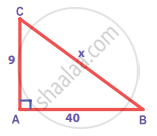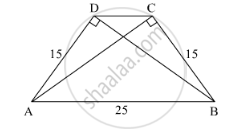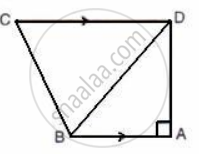Advertisements
Advertisements
Question
Find the unknown side in the following triangles
Solution
From ∆ABC, by Pythagoras theorem
BC2 = AB2 + AC2
Take AB2 + AC2
= 92 + 402
= 81 + 1600
= 1681
BC2 = AB2 + AC2
= 1681
= 412
BC2 = 412
⇒ BC = 41
∴ x = 41
APPEARS IN
RELATED QUESTIONS
A man goes 10 m due east and then 24 m due north. Find the distance from the starting point
In Fig., ∆ABC is an obtuse triangle, obtuse angled at B. If AD ⊥ CB, prove that AC2 = AB2 + BC2 + 2BC × BD
In a trapezium ABCD, seg AB || seg DC seg BD ⊥ seg AD, seg AC ⊥ seg BC, If AD = 15, BC = 15 and AB = 25. Find A(▢ABCD)

In the given figure, AB//CD, AB = 7 cm, BD = 25 cm and CD = 17 cm;
find the length of side BC.
Find the length of diagonal of the square whose side is 8 cm.
The sides of the triangle are given below. Find out which one is the right-angled triangle?
11, 12, 15
In ΔABC, AD is perpendicular to BC. Prove that: AB2 + CD2 = AC2 + BD2
In a triangle ABC, AC > AB, D is the midpoint BC, and AE ⊥ BC. Prove that: AC2 - AB2 = 2BC x ED
If ‘l‘ and ‘m’ are the legs and ‘n’ is the hypotenuse of a right angled triangle then, l2 = ________
If ΔABC ~ ΔPQR, `("ar" triangle "ABC")/("ar" triangle "PQR") = 9/4` and AB = 18 cm, then the length of PQ is ______.
